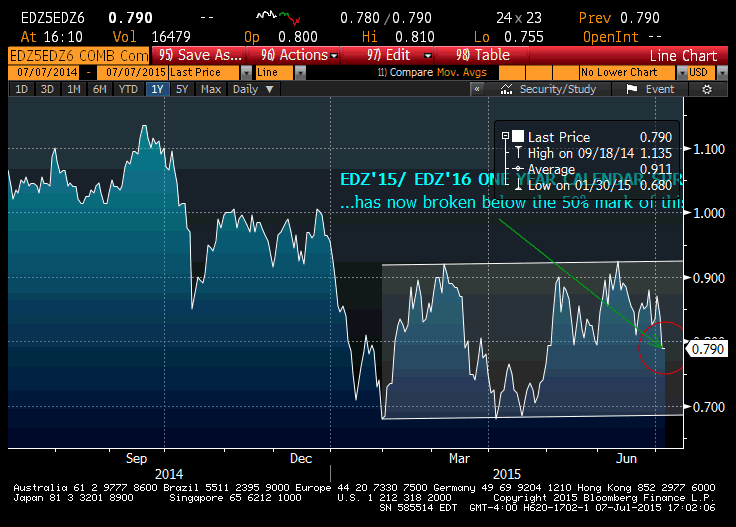There has been amazing volatility the last couple of days in many markets, as the policy of kicking the can down the road and finding last second crisis solutions appears to have come into serious question with Greece. (…not to mention China and Puerto Rico).
Big industrial products have been crushed in the early part of this week. For example, August Crude Oil was oscillating around $60 throughout June, but traded as low as 50.58 Tuesday morning, within spitting distance of the low set in March of 48.71. Sept Copper was as high as 295 in early May, but plunged in the last two sessions from 263 on Thursday to a low of 238.70 yesterday morning, notching a new low for the calendar year. Silver also posted a new low yesterday, trading as low as 14.62. Iron Ore (traded on the Dalian exchange) has cascaded to new lows in the month of July, dropping over 15% just since June 30.
So what are the implications for US monetary policy?
The market had been expecting Fed hikes, but has been slowly squeezing out the probabilities. The commodity moves noted above, along with dollar strength that has occurred as a result of international monetary flows seeking safe haven, have thrown a wet blanket on the Fed’s goal of 2% inflation. There had been expectations of up to two 25 bp Fed hikes this year. The market is now not even pricing certainty of one rate hike by the end of the year. For example, January 2016 Fed Funds (FFF6) settled Tuesday at 99.695 or just 30.5 bps. The June 2015 contract that just expired settled at 99.87 or 13 bps. The spread difference between the two contracts is just 17.5 bps. A rough approximation of odds for one hike this year is therefore around 70% (17.5/25). The same dynamic is evident in EDZ’15 (December ’15 Eurodollar contract). This contract had traded as low as 99.335 in June, a rate of 66.5 bps. As of Tuesday it had traded as high as 99.53 or 47 bps. The recently expired EDM’15 contract went out at 99.72 or 28 bps. So, similar to the January Fed Funds, the spread between the current EDZ’15 contract and the June contract that settled to 3-month libor, is less than 25 bps. In other words, the market is no longer pricing aggressive Fed tightening.
I would posit that because of international uncertainty that has the potential to spill over into US affairs, the Fed will not hike this year.
As I have mentioned previously, another indication of expected Fed tightening policy can be observed in Eurodollar calendar spreads. Below is the one year spread between December 2015 and December 2016 Eurodollar contracts. Roughly speaking, one might say that a spread of 100 bps would be an indication of the Fed raising the FF target four times in 25 bp increments over the year. The range in this spread so far this year has been 68 to 92.5 bps, with 80 bps being the midpoint. Yesterday the spread settled at 77.5.

The strategy of being long near Eurodollar contracts to play the roll up if the Fed stays on hold is again valid. The keys will be Yellen’s speech in Cleveland on Friday on the economic outlook and her semi-annual testimony in front of Congress the following week. I would expect her to highlight international risks to the growth outlook of the US economy.
Alex Manzara




